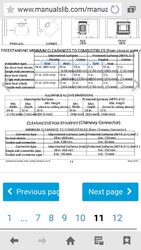Hey Everyone,
Merry Christmas and Happy New Year. I am taking some of my holiday leave and working on the install for the use stove that I purchased, a Hearthstone Shelburne. I am planning on installing this stove in my new sunroom. The ceilings are approximately 10 ft tall. I am wanting to do a horizontal exit from the stove out through a thimble to about 16 ft of class A. The Shelburne actually has a rotating exhaust port that can can vent vertically, or straight out at 90 degrees. Since I am wanting to do a horizontal exit, this seems as if it will work perfectly. My question is whether I need to run a few feet of stove pipe vertically before the horizontal exit, or I can just exit the wall directly behind the stove? From reading the owner's manual, it seems as if this is the intent behind the rotating port, to actually give folks the option to make a direct exit.
Also, from folks who have or may have had the Hearthstone Shelburne, I was wondering how the stove will perform in this type of chimney? I realize that it may take a little coaxing with a hair dryer to get the cold chimney drafting for a cold startup, but once it gets heated, will things work adequately?
Again, thanks so much and Merry Christmas (apologies for the non politically correct seasonal greetings, but I guess I am a bit of non conformist).
Merry Christmas and Happy New Year. I am taking some of my holiday leave and working on the install for the use stove that I purchased, a Hearthstone Shelburne. I am planning on installing this stove in my new sunroom. The ceilings are approximately 10 ft tall. I am wanting to do a horizontal exit from the stove out through a thimble to about 16 ft of class A. The Shelburne actually has a rotating exhaust port that can can vent vertically, or straight out at 90 degrees. Since I am wanting to do a horizontal exit, this seems as if it will work perfectly. My question is whether I need to run a few feet of stove pipe vertically before the horizontal exit, or I can just exit the wall directly behind the stove? From reading the owner's manual, it seems as if this is the intent behind the rotating port, to actually give folks the option to make a direct exit.
Also, from folks who have or may have had the Hearthstone Shelburne, I was wondering how the stove will perform in this type of chimney? I realize that it may take a little coaxing with a hair dryer to get the cold chimney drafting for a cold startup, but once it gets heated, will things work adequately?
Again, thanks so much and Merry Christmas (apologies for the non politically correct seasonal greetings, but I guess I am a bit of non conformist).


